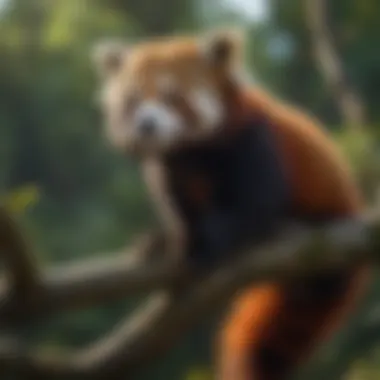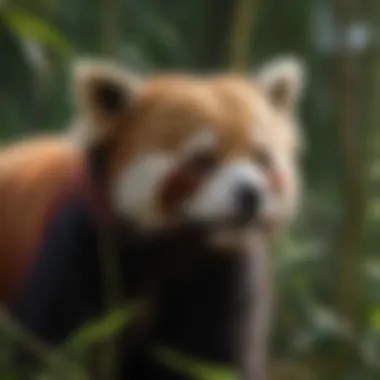Understanding the Critical Endangered Status of Red Pandas


Intro
Red pandas, often overshadowed by their larger relatives, present unique biological and ecological challenges. Their status as an endangered species is a growing concern within conservation circles. Understanding their vulnerabilities requires a look into their habitat, behavior, and the numerous threats they face today. This exploration aims to shed light on the necessity for these lovely creatures and the actions needed to prevent their extinction.
Fascinating Facts About the Animal
Unique Characteristics
The red panda, scientifically known as Ailurus fulgens, is about the size of a house cat, but its appearance is strikingly unique. With reddish-brown fur, a bushy tail, and a face that resembles a raccoon, red pandas have adapted remarkably to their environment. They possess a special thumb that helps them grasp bamboo, their primary food source. This adaptation is essential, given that red pandas spend the majority of their time in trees.
Extraordinary Abilities
Red pandas are not just cute animals; they exhibit fascinating abilities. They are excellent climbers and are mostly arboreal, adept at navigating through the treetops. Their diet mainly consists of bamboo, but they can also consume fruits, acorns, and small animals. Despite their relatively low energy levels, red pandas have the ability to navigate cold mountain environments thanks to their thick fur and unique adaptations to conserve heat.
Behavior and Habitat
Natural Habitats
Red pandas inhabit the temperate forests of the Himalayas and southwestern China. Their preferred environment consists of dense bamboo thickets at high elevations. Unfortunately, these habitats are becoming scarce due to deforestation and habitat fragmentation, leading to a steep decline in their population. The loss of habitat is a direct result of human activities, particularly agriculture and urban expansion.
Social Structures
These animals are mostly solitary creatures. However, they do have specific social habits during the mating season. They communicate through a series of vocalizations and scent markings to establish territories. Red pandas are known to be more active during the dawn and dusk, a behavior known as crepuscular, which helps them avoid threats while searching for food.
Recent Scientific Discoveries
Latest Research Findings
Recent research has focused on the genetic diversity and population dynamics of red pandas. Studies show that small, fragmented populations suffer from low genetic variability, which poses significant risks to survival. This biodiversity crisis makes it crucial for conservationists to understand the genetic makeup of red panda populations.
Breakthroughs in Animal Biology
Innovative research methods, such as DNA barcoding, have enabled scientists to study this species better. These technological advancements provide insights into their breeding patterns and health. Understanding the genetic health of red pandas may help in creating effective breeding programs to increase their populations.
Cultural Significance
Animals in Folklore
Red pandas hold a special place in the cultures of Asia. In certain regions, they are revered as mystical creatures. Their image is often used in local folklore to symbolize peace and solitude. Beliefs surrounding them contribute to local customs and community initiatives aimed at their protection.
Influence on Art and Literature
The allure of red pandas reaches far beyond their habitat. They have inspired various art forms, from paintings to animated films. This influence on art and literature reflects a collective fascination with wildlife, urging audiences to engage with conservation efforts. This cultural relevance is integral to fostering empathy and support for endangered species.
The red panda is not just an animal; it’s an emblem of ecological diversity that demands our attention.
Prelude to Red Pandas
The red panda (Ailurus fulgens) is a small arboreal mammal native to the eastern Himalayas and southwestern China. The significance of understanding red pandas goes beyond just their endearing appearance; it covers ecological, conservation, and cultural aspects. As one of the few remaining representatives of the Ailuropodinae family, red pandas hold a unique position in the biodiversity spectrum. Their role as an indicator species makes them essential in assessing the health of their habitat. Moreover, understanding red panda behavior and ecology provides vital insights into the challenges they face, thus illuminating the urgent need for conservation efforts.
Taxonomy and Classification
The taxonomy of the red panda reflects its unique evolutionary lineage. It belongs to the family Ailuridae, which consists of this single species. Although it shares some similarities with the giant panda, the red panda is distinct enough to warrant its classification as a separate family. Genetically, red pandas are more closely related to raccoons and weasels than to bears. This distinct classification highlights the importance of red pandas in studying vertebrate evolution and ecology, showcasing their unique adaptations to the habitat they thrive in.
Physical Characteristics


Red pandas exhibit several fascinating physical traits. Their red-brown fur provides excellent camouflage in their natural habitat, which consists primarily of forests where they reside among bamboo trees. They have a plump body, a bushy tail, and striking facial markings, contributing to their charm. Typically, adult red pandas weigh between 8 to 14 pounds and measure about 20 to 26 inches in length, excluding the tail, which can add an additional 12 to 20 inches. Their semi-retractable claws and flexible ankles allow them to easily climb trees, where they spend most of their time. All of these characteristics have evolved to help them survive in challenging environments, yet they also make the red panda more vulnerable to habitat disruption and other threats.
Natural Habitat
The natural habitat of red pandas is a crucial factor in understanding their endangered status. The ecological settings where these animals thrive directly affect their survival, necessitating a closer examination of various aspects related to their habitat. Understanding these elements can shed light on why red pandas continue to face threats and how targeted conservation efforts can be structured.
Geographic Distribution
Red pandas primarily inhabit the temperate forests of the Himalayas and the mountain ranges of southern China. Their range extends across several countries, including Nepal, India, Bhutan, and Myanmar. These regions provide necessary features such as bamboo abundance, elevation, and cooler temperatures, which are essential for the red panda's well-being.
The geographic distribution of red pandas is fragmented, often due to human activities like deforestation and agriculture. This contraction of habitat range is alarming and increases their isolation. The remoteness of these habitats also complicates data gathering on their population density, adding a layer to the challenge of conservation.
Habitat Requirements
Red pandas have specific habitat requirements that are vital for their survival. They prefer forests at elevations between 2,200 and 4,800 meters, where bamboo is plentiful. Bamboo constitutes almost 90% of their diet; thus, areas with healthy bamboo growth are essential. Additionally, sheltered places within these forests provide safety from predators and harsh weather.
A few key considerations regarding their habitat include:
- Temperature: Red pandas thrive in cooler climates with moderate rainfall. Their thick fur helps them manage colder temperatures.
- Vegetation: Aside from bamboo, red pandas require diverse flora for their diet and to create a rich ecosystem that supports other wildlife.
- Tree Density: A dense tree canopy is necessary for climbing and nesting, crucial for a species that is arboreal in nature.
The degradation of these environmental conditions can severely impact red pandas, ultimately pushing them toward extinction. Protecting their natural habitat is not merely about preserving a species; it also maintains the broader ecological balance of the regions they inhabit. By focusing conservation efforts on these critical habitats, we can better address the factors contributing to the endangerment of red pandas.
Behavior and Ecology
Diet and Feeding Habits
Red pandas primarily feed on bamboo, which constitutes about 95% of their diet. They have a unique digestive system that is not well-adapted to break down the cellulose in bamboo, resulting in inefficient nutrient absorption. To compensate, red pandas consume large quantities of bamboo each day, often ranging from 20 to 30 pounds. In addition to bamboo, they occasionally eat fruits, acorns, and small animals.
This selective feeding behavior plays a crucial role in their ecology. The availability of bamboo is directly linked to the distribution and survival of red pandas. Any changes in the environment that affect bamboo growth have significant repercussions for the red panda population.
Reproductive Behavior
Red pandas have a distinctive reproductive cycle. Mating occurs typically between January and March. Females attract males with a series of vocalizations and scent markings.
After a gestation period of approximately 130 to 150 days, females give birth to one to four cubs, usually two being most common. The cubs are born blind and depend entirely on their mother for warmth and nutrition.
The female raises the cubs alone, often in hollow trees or rock crevices, providing them shelter until they are about 18 months old. The timing and conditions of the breeding season are critical for ensuring the survival of the cubs, as they need to be born when food is most abundant.
Social Structure
Red pandas are mainly solitary creatures. They establish territories that they mark using scent glands and vocalizations. Males have larger territories than females, often overlapping with those of several females.
During the breeding season, males and females come together. Outside this period, interactions are minimal, and each individual remains largely independent. Their solitary nature is reflective of their ecological niche and resource needs.
Key Points:
- Red pandas have a herbivorous diet, primarily composed of bamboo, shaping their ecological interactions.
- Mating behaviors are intricate, as are the subsequent parenting strategies of females.
- Territoriality and social behavior are crucial aspects of red panda life.
Understanding these behaviors and ecological roles highlights the complexity of red panda survival and the need for targeted conservation strategies.
Threats to Survival
Understanding the threats to red pandas is essential for comprehending their endangered status. These threats are multifaceted and interrelated, influencing not only the survival of red pandas but also the integrity of their habitats and ecosystems. By identifying and analyzing the specific elements, we can highlight the urgency of conservation efforts required to protect this unique species.
Habitat Loss
Red pandas predominantly reside in temperate bamboo forests in the eastern Himalayas and southwestern China. This habitat is critical for their survival as it provides the necessary food, shelter, and breeding grounds. Unfortunately, habitat loss is a significant threat, primarily driven by human activities such as deforestation, agriculture, and urbanization.


- Deforestation: Large areas of forest are cleared for timber and to make way for agriculture. This not only reduces the available habitat but also fragments it, making it difficult for red pandas to move freely between areas.
- Agricultural Expansion: As populations grow, more land is converted for farming. This often results in the destruction of bamboo, which constitutes about 95% of the red panda's diet. Without bamboo, red pandas cannot thrive.
- Infrastructure Development: Roads and urban development contribute to habitat fragmentation. This can isolate populations, reducing genetic diversity and increasing the risk of inbreeding.
Conservation strategies must focus on protecting existing habitats and restoring degraded areas to ensure the longevity of red panda populations.
Poaching and Illegal Trade
Another pressing threat to red pandas is poaching. Illegal hunting for their fur, which is prized in some markets, poses a significant risk. The trade of red panda body parts contributes not only to population decline but also to the creation of a black market that complicates conservation efforts.
- Demand for Fur: Despite being illegal in many countries, the demand for red panda pelts persists. The aesthetic appeal of red panda fur makes them targets for poachers.
- Pets and Attractions: In some regions, red pandas are captured for the pet trade or for display in zoos and aquariums. This often results in a high mortality rate during transit and poor living conditions.
Efforts to combat poaching must include stricter enforcement of wildlife protection laws, alongside education campaigns to raise awareness about the value of red pandas in the wild.
Climate Change Impact
Climate change represents an escalating threat to red pandas' habitats. As temperatures rise and weather patterns shift, the delicate ecosystems that sustain red pandas could be irrevocably altered.
- Bamboo Decline: Climate change could disrupt the growth and availability of bamboo, the primary food source for red pandas. Given that bamboo has a unique flowering cycle, shifts in climate may lead to mass die-offs, leaving red pandas with insufficient food.
- Altered Habitats: Rising temperatures may force red pandas to migrate to higher elevations in search of suitable habitats, but this can lead to overcrowding and increased competition for resources among existing populations.
Addressing climate change is crucial. Strategies should include habitat protection and restoration efforts, as well as policies aimed at reducing greenhouse gas emissions.
The survival of red pandas hinges on our ability to mitigate these threats through targeted action and cooperation on a global scale.
Conservation Status
Understanding the conservation status of red pandas is crucial in shaping effective strategies to protect this vulnerable species. The focus on conservation status allows us to pinpoint the current challenges faced by red pandas and to develop targeted efforts to address these issues. Key considerations in this area include the examination of classifications, population trends, and the effectiveness of current conservation measures.
IUCN Red List Classification
The International Union for Conservation of Nature (IUCN) Red List is a critical tool in wildlife conservation. It assesses the conservation status of species globally. Red pandas are classified as Endangered on this list. This classification stems from the combination of habitat loss, poaching, and low reproductive rates. As a result, recognizing their status helps prioritize conservation efforts and allocate resources effectively.
The Endangered classification signals an urgent need for action. Conservation organizations use this information to raise awareness and mobilize resources for habitat protection and restoration initiatives. The IUCN Red List serves not only as an indicator of a species' risk for extinction but also as a framework for formulating measurable conservation goals.
Current Population Estimates
Estimating the current population of red pandas is essential for understanding their conservation status. As of the latest studies, it is estimated that there are between 10,000 to 20,000 individuals remaining in the wild. This figure varies due to the fragmented nature of their habitats and the specific regions in which they are found.
Key factors affecting these estimates include:
- Geographic Dispersal: Red pandas primarily inhabit the mountain forests of the Himalayas and southern China. Their population is not evenly distributed, leading to regional variances.
- Habitat Quality: Deforestation and habitat degradation have direct impacts on the survival rates of red pandas. Areas with dense bamboo coverage, their primary food source, are crucial for their sustenance.
- Research Methods: Estimates are often derived using field surveys and camera trap studies, which provide insights into population density and dynamics.
Ongoing research and monitoring efforts are vital to formulating accurate population estimates. Understanding these numbers is key to determining appropriate conservation interventions that can help stabilize and, ideally, increase the population of red pandas in the wild. By focusing on their conservation status, we can foster a collaborative approach to safeguarding this unique species for future generations.
Conservation Efforts
Conservation efforts are crucial for ensuring the survival of red pandas. These initiatives aim to strengthen the species' population and improve their habitats. Effective conservation strategies require understanding the challenges faced by red pandas and implementing targeted actions to address them. By focusing on practical and collaborative approaches, we can create a caring environment that allows for the thriving of these unique mammals.
Protected Areas and Reserves
Protected areas and reserves play a significant role in red panda conservation. These designated regions provide safe havens where red pandas can live without the immediate threat of habitat loss and human interference. Establishing national parks and wildlife sanctuaries helps preserve their natural habitats, which are essential for their survival.
Some notable protected areas include:
- Ghangruk National Park in Nepal
- Nanhua National Nature Reserve in China
- Sagarmatha National Park in Nepal
These reserves not only protect red pandas but also promote biodiversity. They support various ecosystems that benefit numerous animal and plant species. Ensuring the continued protection of these areas is vital for the long-term success of red panda conservation efforts.
International Collaboration and NGOs


International collaboration and efforts by non-governmental organizations (NGOs) are fundamental in addressing the red panda crisis. These organizations work across borders to share resources, knowledge, and best practices. NGOs focus on research, community engagement, and raising awareness about the challenges red pandas face.
For example, the Red Panda Network is an NGO dedicated to the conservation of red pandas through habitat preservation and community involvement. Collaborating with local communities helps ensure that conservation strategies are culturally sensitive and effective.
Additionally, partnerships with international bodies like the World Wildlife Fund enhance conservation efforts through funding and technical support. These collaborations magnify the impact of conservation initiatives and create a unified front to protect red pandas.
Community Involvement and Education
Community involvement and education are essential components of successful conservation efforts. Engaging local populations enables them to understand the importance of preserving red pandas and their habitats. Education programs can foster a sense of responsibility towards wildlife conservation.
By promoting sustainable practices and creating economic opportunities linked to conservation, communities become active participants in preserving red pandas. For instance:
- Eco-tourism initiatives can provide jobs while promoting wildlife conservation.
- Local workshops can educate communities about the ecological significance of red pandas.
These educational efforts can foster a culture of conservation. As communities become more educated, they are more likely to take actions that benefit local wildlife. This grassroots involvement amplifies the effectiveness of conservation measures, creating a resilient support system for red pandas.
"Preservation of red panda populations does not rest solely on large organizations, but rather on the collaboration of everyone involved at the grassroots level."
Cultural Significance
The cultural significance of red pandas extends beyond their endearing appearance. In various societies, they hold symbolic meaning and represent harmony with nature. Their image frequently appears in art, folklore, and media, underscoring their role as a cultural ambassador for wildlife conservation.
- Symbol of Conservation: Red pandas, being endangered, symbolize the broader issues of wildlife conservation. Their plight draws attention to habitat destruction and climate change, making them a focal point for educational campaigns.
- Cultural Identity: In some regions, red pandas are integral to local traditions and narratives. Their presence in folklore contributes to a sense of cultural heritage, linking communities to their natural environment.
“The image of the red panda has the power to inspire change, fostering a connection between humans and wildlife.”
Representation in Art and Literature
Red pandas have captured the imagination of artists and writers alike. Through various forms of expression, they embody themes of gentleness and resilience. In literature, red pandas appear as characters, often representing innocence or the need for protection. Children’s books featuring these animals tend to convey messages about caring for the environment.
In art, red pandas are often depicted in a contrasting colorful way, representing both playfulness and the harsh realities of their endangerment. This duality helps raise awareness about the efforts needed to preserve their species and habitat. Artists use the red panda as a medium to express concern over environmental issues, ensuring that their significance is felt not just visually, but also emotionally.
Role in Ecosystem
Red pandas play a crucial role in their ecosystem. As herbivores, they primarily feed on bamboo, which influences the vegetation structure in their habitat. By feeding on bamboo, they help maintain the health and growth of these forests, enabling other species to thrive.
Their foraging patterns contribute to seed dispersal, promoting biodiversity in their environment. This activity is essential for the regeneration of plant species, affecting the overall ecological balance. When we understand the role of red pandas in the ecosystem, we realize that their extinction would have ripple effects throughout their habitat.
- Bamboo Forests: The health of bamboo forests, where red pandas reside, directly impacts the entire ecosystem. These forests provide shelter and food for various species.
- Indicator Species: As an indicator species, the red panda reflects the health of its environment. Their survival signals a balanced ecosystem, making their conservation vital for broader ecological stability.
In summary, red pandas are not merely creatures of charm; they are vital components of their ecosystems and bear significant cultural influence. Recognizing their importance helps galvanize conservation efforts and fosters a deeper appreciation of our planet’s biodiversity.
Future Perspectives
Understanding the future perspectives of red pandas is crucial. The challenges they face today will shape the coming years for this species. Special attention to their well-being forces awareness. It stresses the importance of combined efforts to protect them.
Challenges Ahead
Several obstacles hinder the survival of red pandas. Habitat loss due to deforestation is a primary concern. The increased development of infrastructure often results in fragmentation of their living space. As a result, red pandas find it harder to find food and mates.
Another challenge is climate change. Ecosystems shift as temperatures rise, impacting food sources. It is essential to study these changes closely. Understanding how habitat alteration affects red pandas can inform action plans.
Additionally, poaching and illegal trade of wildlife remain threats. Red pandas are often targets for their fur, which is highly valued. Wider awareness and stricter enforcement of wildlife protection laws are necessary.
Hope for Red Pandas
Despite the challenges, there are reasons for optimism regarding the future of red pandas. Conservationists and organizations are focusing on protecting habitats. This effort ensures that red pandas have suitable environments to thrive. Reforestation projects play a significant role by restoring their natural habitats.
Collaboration among countries and NGOs has been fruitful. Initiatives such as captive breeding programs provide support for dwindling populations. They help to ensure genetic diversity, which is vital for long-term survival.
Education and community involvement can also shape a better future. Local communities become custodians of their environment through education programs. Enhancing local appreciation of red pandas leads to positive action.
"The survival of red pandas is not only crucial for the species itself but also for the health of its ecosystem."







